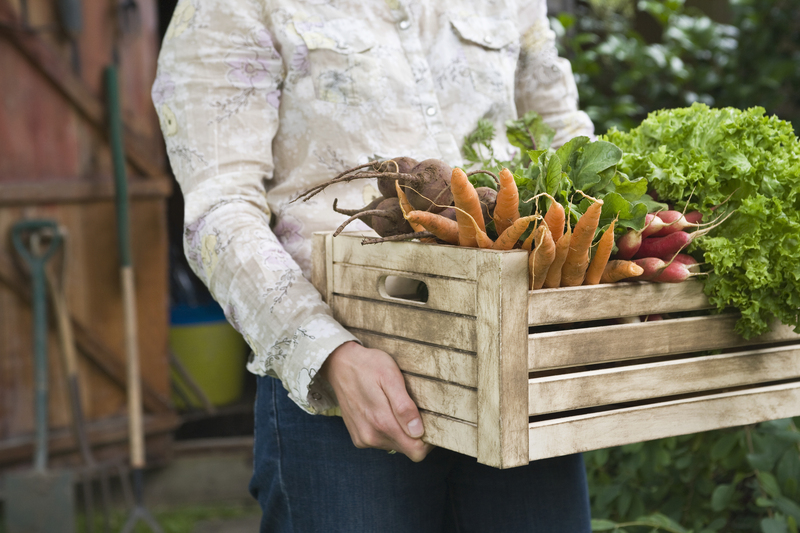Resilient Gardens: Preparing for Severe Weather Challenges
Posted on 14/06/2025
Resilient Gardens: Preparing for Severe Weather Challenges
In recent years, the frequency and intensity of extreme weather events have increased, making resilient gardens not just a trend but a necessity. Whether your region faces violent storms, prolonged droughts, flooding, or unexpected cold snaps, your garden can thrive if you're prepared. This comprehensive guide delves into how you can build and maintain a resilient landscape, ensuring your green space withstands severe weather challenges and continues to flourish.

Understanding the Importance of Weather-Resilient Gardening
_Robust gardens aren't just about looking pretty--they're about survival and sustainability._ As our climates shift, it's critical to adapt your gardening practices and plant selections. Severe weather events, such as heavy rains, hail, strong winds, and droughts, can decimate traditional gardens. By focusing on garden resilience, you create an environment that can recover faster, suffer less damage, and support local wildlife and ecological health.
Why Develop a Resilient Garden?
- Protect your investment: Gardens often require years to mature. Severe weather can reverse years of progress in a single day.
- Maintain food security: For those growing their own food, a resilient garden means more consistent harvests, even during unfavorable weather.
- Support local biodiversity: Robust gardens offer refuge and resources to pollinators and beneficial insects in tough times.
- Reduce maintenance and costs: Well-adapted gardens recover more easily, requiring less time and money for repair.
Strategies for Creating a Weather-Resilient Garden
The first step is understanding your local climate and identifying the main severe weather threats in your area. Whether it's hurricanes, blizzards, heatwaves, or unpredictable freezes, tailor your approach with the following foundational strategies:
1. Evaluate and Improve Soil Health
A resilient landscape begins with healthy soil. Soil structure influences how water drains during floods and sustains plants during drought.
- Increase organic matter: Add compost, leaf mold, or well-rotted manure. These improve soil's moisture retention and drainage.
- Use mulch generously: A thick layer of organic mulch moderates soil temperature, conserves moisture, and prevents erosion caused by heavy rain.
- Test your soil: Know your soil's pH and nutrient content to select plants that will thrive without excessive amendments.
2. Smart Plant Selection for Resilience
Choosing the right plants is central to storm- and drought-tolerant gardening. Native plants are naturally adapted to local conditions and require less input for survival.
- Focus on natives: Consult your agricultural extension office or local native plant societies for recommendations.
- Choose drought- and flood-tolerant species: For example, switchgrass, coneflower, sedum, and black-eyed Susan can withstand harsh weather.
- Diversity is key: Encourage a resilient ecosystem by planting a wide range of species to reduce the impacts of disease or weather events.
- Consider windbreaks: Plant dense hedges or small trees as living barriers to reduce wind damage.
3. Strategic Garden Design
Thoughtful design increases your garden's ability to bounce back from adverse weather.
- Elevate beds: Raised beds offer better drainage during heavy rains and make replanting after damage easier.
- Contour the landscape: Use berms, swales, and other land-shaping techniques to direct and absorb water efficiently.
- Group plants by needs: Place drought-tolerant plants together, and keep thirsty species near the house or water sources.
- Install ground covers: Ground-hugging species reduce erosion and temperature swings.
Protecting Your Garden from Specific Severe Weather Events
While proactive planning is essential, different severe weather challenges call for customized solutions. Here's how to prepare your resilient garden for some of the most common threats:
Dealing with Heavy Rain and Flooding
- Improve drainage: Use French drains or gravel trenches to divert excess water away from flower beds.
- Choose flood-resilient plants: Marigold, iris, and certain sedges tolerate wet feet.
- Anchor soil: Dense root systems from ground covers and perennial grasses prevent erosion during floods.
- Plant on mounds: Raise sensitive plants to help prevent waterlogging.
- Install rain gardens: These are designed to temporarily collect and filter runoff, protecting the rest of your yard.
Guarding Against Drought and Heatwaves
- Mulch deeply: Protect roots from heat and reduce evaporation with a 2-3 inch layer of organic mulch.
- Harvest rainwater: Use barrels to collect water for use during dry spells.
- Practice drip irrigation: This delivers water right to the roots, minimizing waste.
- Water at dawn or dusk: This prevents evaporation and reduces plant stress.
- Drought-resistant plants: Lavender, yarrow, and salvia are excellent choices for dry climates.
Defending Against Strong Winds and Storms
- Secure structures: Properly anchor trellises, arbors, and garden furniture.
- Prune regularly: Remove dead or damaged branches to reduce breakage and wind resistance.
- Plant windbreaks: Rows of sturdy shrubs or trees can buffer your space.
- Stagger planting: Grouping plants of varying heights can absorb and deflect wind energy.
- Use staking and supports: Young trees and delicate plants benefit from added stability.
Adapting to Sudden Cold Snaps or Frost
- Plant hardy species: Choose plants that can tolerate unexpected temperature drops.
- Protect with covers: Use burlap, frost cloths, or even old sheets on cold nights.
- Mulch for insulation: A heavier mulch layer keeps roots from freezing.
- Utilize microclimates: Place sensitive plants near heat-retaining walls or south-facing spots.
- Water wisely: Well-hydrated soil loses heat more slowly and can help buffer root temperatures.
Integrating Technology and Sustainable Practices
The modern resilient garden benefits from both smart technology and age-old wisdom.
Smart Irrigation Solutions
Self-regulating irrigation systems, such as drip lines paired with weather-based controllers, maximize water efficiency. Sensors can adjust watering schedules based on rainfall or soil moisture, ensuring your plants always get the right amount of hydration--especially crucial during drought conditions.
Rainwater Harvesting Systems
Collecting rainwater with barrels, cisterns, or underground tanks adds another layer of resilience, especially in regions prone to water restrictions.
Soil Moisture Monitoring
Digital meters help you track real-time changes and prevent both overwatering and drought stress. They are invaluable for responsive gardening and early detection of potential issues.
Compost and Mulch Management
- Continuous Composting: Composted organic material replenishes lost nutrients and strengthens soil structure after severe weather events.
- Dynamic Mulching: Adjust mulch thickness seasonally; increase before storms and replenish after heavy rain.
Restoring Your Garden After Severe Weather Events
No matter how well you prepare, some weather extremes can cause unavoidable damage. The key to a truly resilient garden is how quickly it recovers.
Steps for Recovery and Restoration
- Assess the damage: Prioritize safety, especially if structures or trees are compromised.
- Remove debris: Clear away fallen branches, leaves, and ruined plant material to prevent disease.
- Prune judiciously: Cut away broken stems and reshape plants to encourage healthy growth.
- Aerate compacted soil: Heavy rains and flooding can compact the earth; loosening it helps roots breathe.
- Feed and hydrate: Provide a balanced fertilizer and thorough watering to give surviving plants a boost.
- Reevaluate plant choices: Replace failed species with more resilient varieties as needed.
- Replant smartly: Take advantage of bare spots to experiment with new, more weather-adapted plants.
Tips for Year-Round Garden Resilience
Maintaining a resilient garden is an ongoing process. Use these year-round strategies to stay ahead of the weather:
- Keep up with weather forecasts: Advance knowledge allows you to act fast--covering sensitive plants, pruning, or moving containers inside.
- Rotate crops and plants: This discourages pest build-up and creates a stronger, more diverse garden community.
- Regular soil testing: Ensure your soil health is optimal for robust plant growth and better stress tolerance.
- Inspect your garden infrastructure: Regularly check fences, supports, and paths for stability.
- Promote beneficial wildlife: Frogs, birds, and predatory insects offer natural pest control, reducing stress on plants before and after severe weather.
- Plan for succession planting: Quick-growing replacements ensure you never have bare or depleted beds after an event.
- Document and learn: Keep a weather and plant journal to track what works and what doesn't each season.

Case Study: Building Storm-Ready Gardens
_Consider the story of a Florida home where hurricanes are common. By replacing delicate annuals with native palmettos and sea oats, and adding robust berms around vulnerable beds, the homeowners reduced wind and flood damage by over half. Their raised vegetable beds were secured with heavy timber, and they staked young fruit trees for added support. Even after a direct hit, the garden was bruised but not beaten--most plants bounced back within weeks._
Conclusion: The Future is Weather-Adapted Gardens
As climate uncertainty intensifies, investing in a weather-resilient garden is the ultimate act of stewardship--protecting your landscape, your harvest, and your ecosystem. Whether you're a beginner or an expert, the strategies outlined here will help you transform your space into a thriving, adaptable, and sustainable oasis.
Remember, the essence of resilient gardening isn't perfection--it's adaptability, diversity, and an ongoing willingness to learn. By embracing change and planning wisely, you ensure your garden not only survives but thrives through every storm.
Further Reading and Resources
- USDA Soil Health Resources
- Native Plant Finder
- National Gardening Association: Building Strong Gardens
- Local Cooperative Extension Services
Take action today! Start small, experiment, and watch your garden become more robust each year, ready to meet the severe weather challenges of tomorrow.

